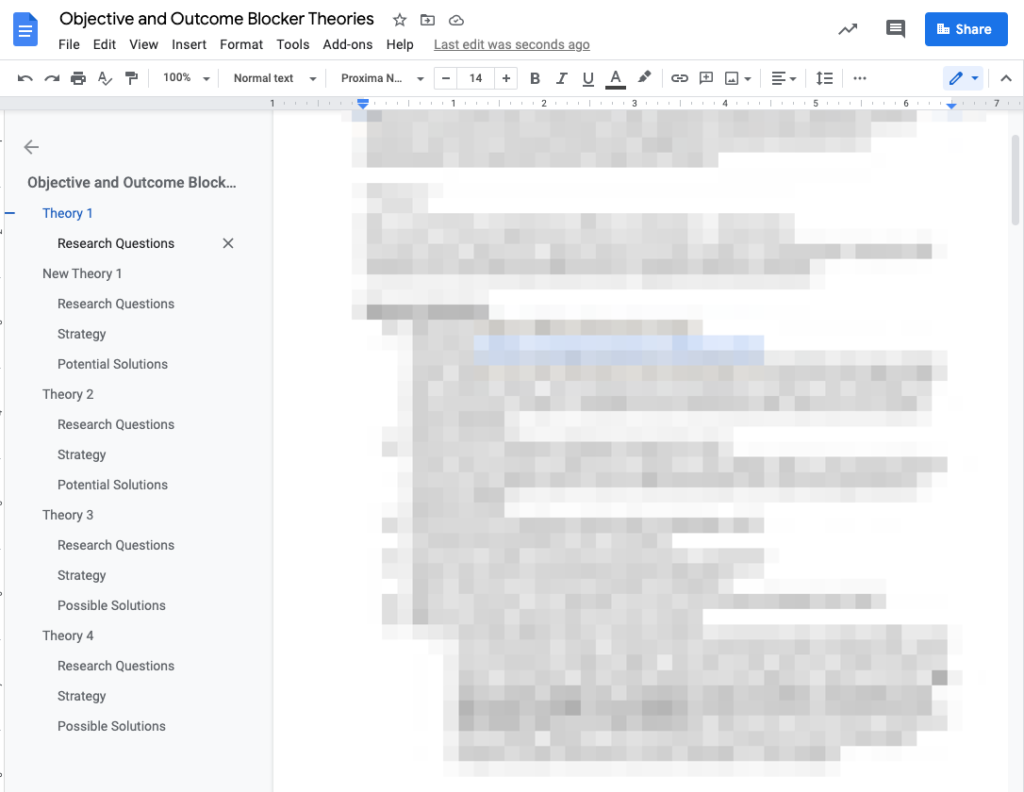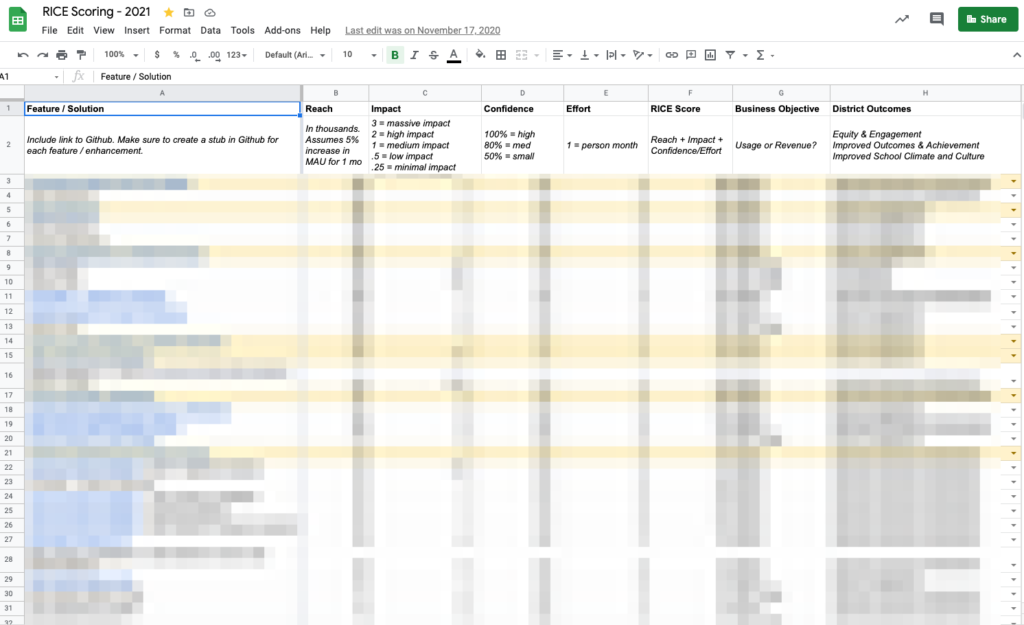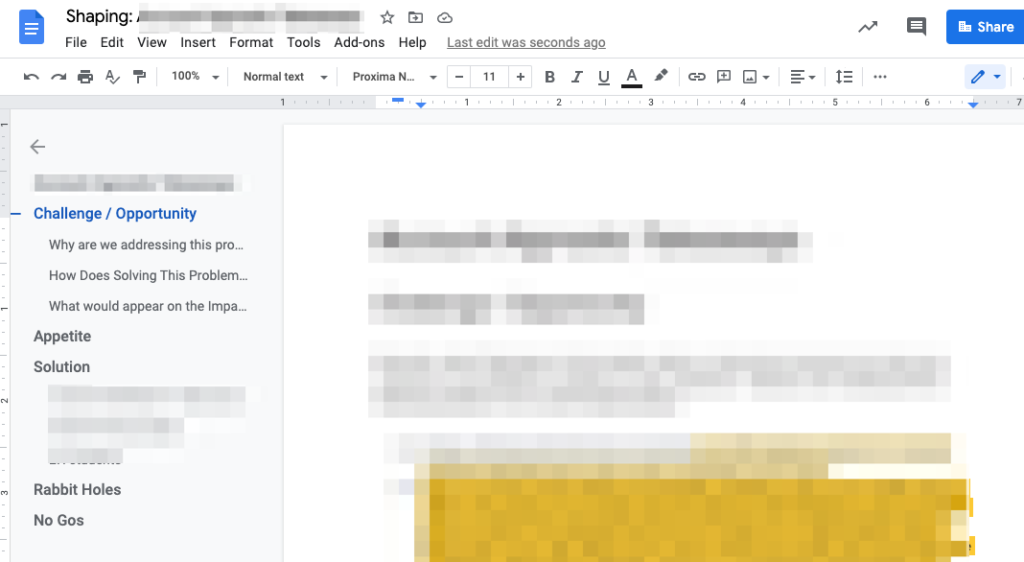Product Management Process: How I work
A real-life example of my product management process
Please note that many of the images used here have confidential information masked.
The Challenge
At the end of 2020, we had a clear idea of the main strategic themes we would address during the year. My challenge was to identify which product and feature functionality improvements would make the biggest impact for that strategic theme. Sorry to be so vague, but our roadmap is proprietary and not something I can share details about.
Since I joined Pear Deck in 2017, we have released about 30 new features and new functionality. That is a lot. Our organization was also moving into a new phase of maturity as a result of our continued success. We could no longer make decisions like we did when we were a scrappy start up, we were too big.
My part in our roadmap planning process
Figuring out which features and functionality will be the most valuable to our customers and our business is my main concern, and it’s not easy. Luckily, I have a process that helps ensure that I, my leadership, and design and engineering colleagues feel confident in the work we plan to do.
Overview of the product management process I use
The nice thing about using a fairly standard product management process, is that it allows you to achieve repeatable results. There are always tweaks and refinements that can be made, but this process has been working well for me.
- Research and discovery
- Aligning customer needs with business strategy
- Forming theories to be proven or disproven
- Prioritization to narrow down the options
- Outcome mapping
- Defining the tactical approach
My goal is always to provide enough clarity to the team to allow them to take the project and run with it when we are ready to enter build phase.
Research and discovery is ongoing
One of the things that makes Pear Deck special is its responsiveness to teachers’ needs. In fact, I’d say it is the cornerstone of our product management process. Most of our new features and enhancements originate from teachers’ requests and suggestions. Of course, we don’t have enough engineering and design staff to build every feature teachers want, so we have to continually prioritize and adjust our plans.
Our unique challenge this year revolved around changes to the market and education overall as a result of COVID 19. Our teachers were using our software in ways we never imagined just a couple of years ago. How could we ensure our product continued to be essential for teachers in this new environment? How did we ensure the work we did was still valuable after COVID 19 and a return to a new normal?
Valuable sources of information
We have many rich sources of information about our customers wants, needs, and pain points. I’ve listed some of the most valuable sources of insights below.
- Funnel analysis
Where were people dropping out of our product?
- Generative user research sessions
What needs do our customers have that we haven’t considered yet.
- Feature requests
What needs were people expressing the most frequently?
- Help desk inquiries
What was frustrating or confusing people the most?
I spend a significant portion of my time on user research and discovery every week. To ensure I have the most impact on our Product team’s priorities while using my product management process, I regularly report high level research findings and recommendations.
These research findings and recommendations are essential. They build foundational empathy. That is, they allow to our leadership team to better understand the core issues our customers face.
Aligning business strategy to my roadmap recommendations
To ensure my recommendations will be useful, I collaborate with our other product manager and the leadership team to translate the larger business strategy into a set of theories about how our product team might support the success of the business strategy.
I create a simple Google document with three to four larger theories and use that document as a tool to inform and align our team on a weekly basis.
Forming and exploring theories and hypotheses
During every planning cycle, I use a theory document to organize and communicate my thinking. A theory is a statement about what is blocking our customers from doing the things they need to do to help us meet our strategic goals.
Each theory has a set of research questions we need to explore to validate our assumptions. As research is completed, I narrow in on a specific product strategy.
We usually have a long list of solutions and ideas, and if we know of solutions that would fit the identified strategy, those are included in this document as well.

This document includes a list of research questions organized by theory. It also includes a list of possible solutions that might be related to our theories, strategies, and hypotheses.
Prioritization
Some prioritization happens in the theory document, but there are still too many ideas to pursue at this point in my product management process. It’s time to narrow down and prioritize strategies and solutions. To help focus my work, I also do a special version of RICE analysis. Traditional RICE analysis considers feature reach, impact, confidence, and an estimation of effort. My version also considers whether the proposed solution aligns with product values and higher level business objectives.

Outcome mapping
Since our strategic goal is to achieve specific outcomes, our product team typically operates in an “outcomes driven” framework. We do this to avoid the trap of “inputs-first” or “solution-first” thinking. With solution-first thinking, it’s difficult, if not impossible, to be confident we will meet our goals. We have a ‘hunch’ or a gut feeling, but we haven’t spent the time necessary to evaluate that hunch.
Outcome mapping is a useful activity where we:
- start with a desired strategic goal
- identify who can help us meet that goal
- identify what is blocking those people helping us meet that goal
- determine how we could remove our customers blockers to influence their actions and behaviors
- outline the tactical steps required to deliver and support functionality that removes our customers blockers
An outcome map focused on different types of teachers

In the example above, I mapped a series of proposed solutions from the theory document, to blockers I had identified for specific customer segments. Since our product is designed to enhance instruction, I also mapped these blockers to specific instructional strategies and outcomes. Then, I identified solutions that would be most effective in removing our customers blockers.
Determining a tactical approach
Once I’ve done the thought work to determine which solutions have the most likelihood of helping us meet our strategic goals, I can dig in and determine the specific tactical approaches we may take.
At this point, I’ve been collaborating with product management and senior leaders to prioritize a more constrained and focused set of problems to explore.
We do this work by using our own version of the Shape Up Process outlined by Basecamp. We don’t follow every aspect of that process, but we do find it a useful tool to give us the space to thoroughly explore potential solutions before our engineers spend any time building the product.
Shaping the work to be done
I generally shape one initiative at a time. I use the shaping document as a tool to explore clearly make the business case for the proposed work and explore possible solutions with engineers and UX designers. As we collaborate, we are able to determine which approaches may be the most feasible and effective.

This document is also a tool we use to communicate the severity of the problem we are trying to solve, and help our stakeholders understand what our proposed solution entails.
Results
This process is ongoing, and has a number of positive results. We are able to move fast and build the right things. We do this by having:
- A set of recommended product strategies to serve as our guiding light for all product development and roadmap decisions
- A prioritized roadmap lane with a narrow list of initiatives that addresses our strategic goals
- Cross-functional alignment on what we’ll be working on and why we’re working on it
- A list of clear user research needs, so we were able to do more targeted and timely user research
As I write this, we are building our first big feature enhancement of 2021, and the entire team understands the core problem we are trying to solve, why we are spending time on this now, and what the bare bones of the solution must include.